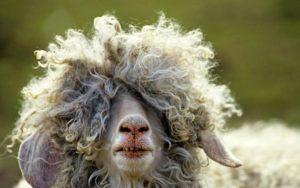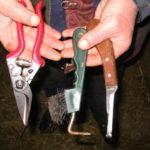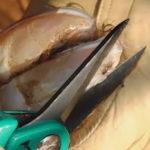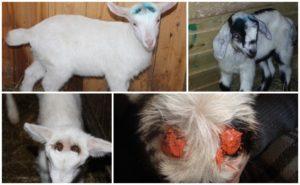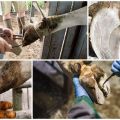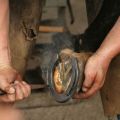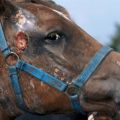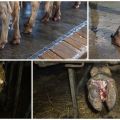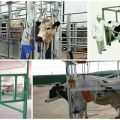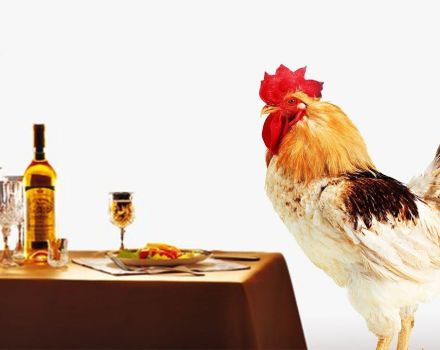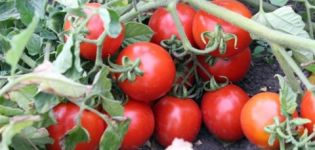How to properly trim the hooves of a goat at home and tools
Goat hooves grow throughout the life of the animal and need processing. Without pruning, they become a source of infection, interfere with walking. How to independently trim the hooves of a goat at home, what tools to use at the same time, this issue worries novice farmers with large herds of cloven-hoofed animals and the owners of only one goat.
Why are the hooves of goats trimmed?
All goats have to systematically cut hooves and handle them. Growing back, they become clogged with mud, injuring the legs of the animal. Goats stop running, lose their appetite, then try to move less, often lie down. They become obese, milk yield decreases. A goat with untreated hooves may misplace legs and experience feeding and drinking problems. Joint deformity is common. Parts of untreated hooves that have sunk into the skin injure it, infection easily gets into the wounds, and inflammation begins. Animals are precariously on their feet, limping.
Under natural conditions, goats wash the overgrown stratum corneum on stones or hard soil, so pruning is not required. When kept at home, they move much less, in winter they are on the thick litter of the barn, therefore they need help. For kids, hoof trimming is performed from the age of 3 months.
Optimal timing
So that the goat does not experience any inconvenience, it is recommended to trim the hooves at least 2 times a year. This is done in autumn and spring without fail, at other times - if necessary. The previously keratinized layer is softened by allowing the animal to walk in the snow or on fresh grass after rain. Before entering the pasture in the spring, the hooves are necessarily cultivated, since in winter they grow more intensively than in other seasons. In summer, the overgrown layer is partially removed during grazing and walking.

Required set of tools
To properly trim the nails of a goat, you should stock up on improvised tools. In work, you cannot do without special equipment:
- a hook for cleaning hooves from dirt, manure, small stones;
- hoof scissors with medium handles; they can be purchased at pet stores or online;
- garden pruner, it is convenient to cut off the stratum corneum with the thin ends of the blades;
- a sharp table knife;
- garden shears;
- hoof knife;
- scissors and hacksaws for metal;
- for hooves that are too hard, side cutters can be useful.
The hoof knife can be used with experience in pruning, otherwise it is easy to injure or inflict it on the animal. In addition to tools, you must stock up on hot water, a pink solution of potassium permanganate or blue copper sulfate; to wash the hooves after trimming, they can also be treated with creosote. Additionally, it is convenient to use special means that protect the hooves from infection, hoof rot, for example, "Kubatol". They are purchased from veterinary pharmacies or pet stores.
Experienced farmers use a less extensive toolbox. If a person does not yet have the practice of performing this procedure, it is better to contact a more knowledgeable breeder and order pruning, carefully observing the process, or watch a few training videos first.
Animal preparation
Hoof trimming is intimidating to a goat, even if it has gone through this procedure more than once. Young artiodactyls are especially restless. To prevent the animal from kicking, it can be tied in a special machine or piled on its side or back. A second person may be helpful to deal with the goat. Suyagny goats are exempt from the procedure. They need to trim their hooves before mating and after lambing.
If the goat is standing in a special machine, the front hooves are trimmed by raising the leg to chest level or moving it back and slightly to the side.
The hind legs are bent at the knee, also pulling back. In order for the goat to calmly endure pruning, you need to give her something tasty and gently stroke the animal during the procedure.
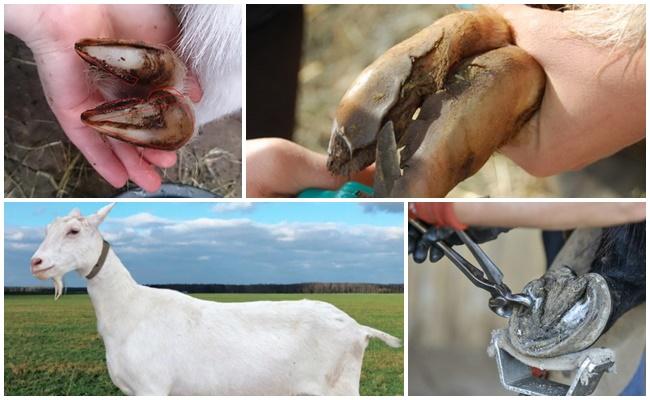
Pruning technique
Each hoof should be thoroughly cleaned to remove dirt, droppings and grass. To soften the old stratum corneum, you can use warm water, clean them with a special hook or the end of scissors, additionally removing dirt with a brush and rinsing with clean water.
Important: Running hooves cannot be straightened in one go, it will take several trims.
Leveling is carried out, often cutting off the slightly overgrown layer (every 2-3 weeks). After 3-5 circumcisions, the plane of the hoof appears, the blood vessels go deeper, the animal begins to walk normally. When trimming hooves, pay attention to odor. If it is unpleasant, putrid, you should look for and handle the damage.
The hoof horn is carefully cut and a plane is leveled parallel to the top edge of the hooves. After pruning, the goat should stand firmly on its feet. The hooves after trimming should remain dry and white, if they are slightly pinkish, then the vessels are close. With inaccurate pruning, blood may appear, then the wound should be treated with iodine, a solution of potassium permanganate, copper sulfate or furacilin.
Healthy hooves are hard, white and dry. Animals do not experience discomfort when walking, they are active while walking. You should pay special attention to the goat if it starts limping, stumbling, or trying to lie down. Perhaps the hoof has been injured by a sharp branch, stone, or it is time to trim it. If the condition of the hooves is not neglected, it is easy to help the goat. It is enough to rinse the leg, find damage, treat the wound. Therefore, you should not neglect such an important procedure.
